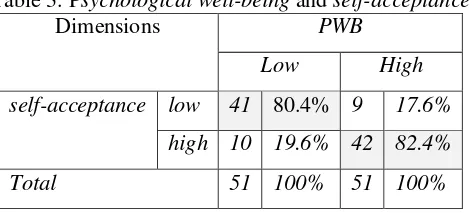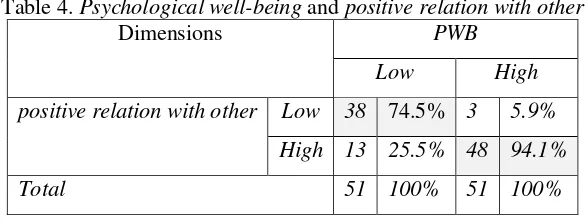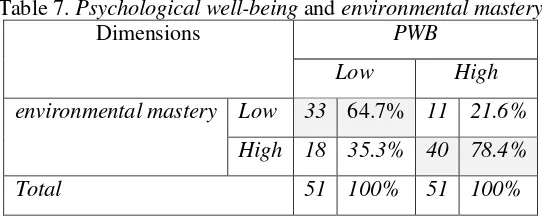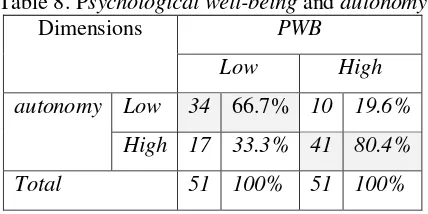PSYCHOLOGICAL WELL-BEING OF
HIV POSITIVE PATIENTS (AGE 20-34 YEARS) IN BANDUNG
Vida Handayani
Ira Adelina
Maranatha Christian University vidahan@gmail.com adelina_ira@yahoo.com
Abstract
HIV-positive patients appear the same as other people. Physically they look healthy and able to do their daily routines well enough, even though their body’s immunity keeps decreasing. They will lose body weight drastically and easily get sick, trivial illness will take longer time to be cured. Problems that arise in HIV-positive patients were not only physical health problems but also psychological problems. They received a variety of evaluation and negative reactions from the environment, they are still often regarded as a disgrace for the community. The presence of HIV in the body can bring the patient in an unpleasant and stressful situation, making them difficult to accept the fact that they are exposed to the virus. It can also affect the patient in carrying out their developmental tasks. The existence of various problems faced by HIV-positive patients could influence their psychological well-being. Psychological well-being entails having a rich perception of various experiences and successfully manages the challenges and difficulties that may arise (Ryff and Singer, 2003).
This research was conducted to get description of the psychological well-being in HIV-positive patients (aged 20-34 years) in Bandung. The method used in this research is descriptive method with survey techniques. The sample selection was done by using
accidental sampling, with a total sample of 102 patients. Measuring instruments used in this study were psychological well-being questionnaire adapted from the scale of psychological well-being compiled by Ryff (1989), consists of 84 questions which is a self-report and objective tests to measure six dimensions of psychological well-being. The validity test obtained 69 valid items (0.300-0.760) and the reliability was 0.893.
The result showed that there were balance between HIV-positive patients with high psychological well-being (50%) and low psychological well-being (50%). Patients with high psychological well-being, in general have a high degree on 2-6 dimensions and vice versa.
Key words: HIV-positive patients, psychological well-being, survey
Introduction
Human Immunodeficiency Virus (HIV) is a virus that attacks the human immune
(AIDS) (Murni, 2003). Patients infected with HIV-positive means HIV existed in the body,
but not yet showing symptoms of AIDS. Experts estimated that 50% of patients who are HIV
positive will show symptoms of AIDS within 10 years, and sooner or later almost all people
that were infected with HIV will develop AIDS and die because of it. HIV patients is usually
feel well and appeared to be healthy like people in general, but can pass it to other people
(Djoeran, 2004).
HIV-positive patients can do their daily routines well enough. However, their body’s
immunity keeps decreasing, so patients become more susceptible to disease. Trivial illness
will take longer time to be cured. Because of these, HIV-positive patients is expected to be
more vigilant in living their life. Patients can aslo experience discrimination from the
neighborhood who still think negatively about the virus in their body, they are still often
regarded as a disgrace to society. Society considers that HIV transmission associated with
same-sex sexual relations, used of illicit drugs using a syringe, free sex, and other deviant
behavior, so that those who are HIV positive are considered deserve being punished. Their
health condition and various judgement from the environment will be a challenge for
HIV-positive patients, these things can affect how they optimize various aspects of life.
Evaluation of a person against himself which is the result of evaluating the
experiences of his life are known as psychological well-being. These evaluation may include
the acceptance and recognition of their situation, relationships and life goals that are owned,
the ability to become independent individuals, and self-development. Patients with high
psychological well-being would be able to live their lives optimally. They can accept and
recognize their circumstances and status. They also have a warm relationship with others,
important related to themself, and seeks to develop their potentials. Conversely, patients with
low psychological well-being will feel dissatisfied with their life. They cannot accept their
state of self- that were contracted with HIV and the existing shortcomings in themselves and
less able to establish warm relationships with others. They live their lives with less optimal
than other, do not even have or lose their life goal. Such situation is not expected, since this
state makes the patient feel uncomfortable and can bring the patient into a state that is
unpleasant. According to Drs. Nursalam, unpleasant feelings can accelerate the onset of
AIDS, and even increase mortality (Nursing Care In Patients Infected with HIV / AIDS,
2007). Therefore, this study made to find out how the psychological well-being in
HIV-positive patients in Bandung.
Conceptual Framework
Psychological well-being are not limited to feeling happy, satisfied with life lived or
absence of negative feelings, unpleasant experience that were used to describe a life that
were well lived. According to Ryff and Singer (2003) psychological well-being formed from
a variety of perceptions of various experiences and the success of overcoming various
challenges and difficulties that arise in life. Psychological well-being consists of six
dimensions, namely: self-acceptance, positive relations with others, environmental mastery,
personal growth, purpose of life, and autonomy.
Self-acceptance is considered as an important part of well-being and positively
related to one's own opinion of themself, referring to the formation of self-regard, which
formed by honest self-assessment. Individuals are aware of their weaknesses and limitations,
but still has willingness to acknowledge and accept “myself” as is.
Positive relations with others is an individual assessment of the ability to strengthen
relationship and the existence of relationships with others that are warm, trusting, and
intimate. Positive relations with others including endurance, individual pleasure and
satisfaction that comes from closeness (intimacy) and the love they have. Various theories
about the stages in adult development also emphasize the close relationships with others
(intimacy), direction and attention from others (generativity).
Autonomy involves the ability to withstand the social pressures, that individuals can
think and act according to standards and values are that were internalized (Ryff, 1989a). This
dimension also refers to the ability to drive them to achieve what is desired and believed,
even when it is contrary to the views or customs in society.
Environmental mastery, include the challenges faced by individuals to master the
environment, as well as the circumstances in which individuals recognize their personal
needs and desires, and feel able to take an active role in getting what they need from the
environment. This dimension is also regarded as an important factor in well-being. This
ability requires the skills to create and maintain an environment which is considered
beneficial for the individual. The ability to choose or create a suitable environment for their
mental condition defined as a mental health characteristics. For an individual, to be able to
adequately control its environment, will requires the ability to regulate and control the
complex environment around them, the need to move forward, change the world creatively
Purpose in life is one of dimension of psychological well-being, which is the way
someone looked at their lives; including the purpose of life and appreciation that life has
direction. The definition of maturity is also clearly emphasizes the sense of purpose in life
and the sense of direction and intention. Individuals with positive function have target in their
life, a clear intention and direction, all of this will give meaning to life (Ryff and Singer,
1966 in Hidalgo et all., 2010).
A final dimension of psychological well-being is personal growth, namely the
assessment of one's ongoing efforts to develop the skills and talents (Ryff, 1989a). This
dimension relates to an individual's ability to realize the potential and talent he possesses to
develop a variety of new things. Often this is also related to how individuals face many
difficulties which required him to find strength from within themselves to overcome it (Ryff
and Singer, 2003 in Hidalgo et all., 2010). It is also associated with openness to new
experiences which are key characteristics of the individuals who serve in their entirety.
Methods
The method used in this research is descriptive method with survey techniques. The
sample selection was done by using accidental sampling, with a total sample of 102 patients.
Measuring instruments used in this study were psychological well-being questionnaire
adapted from the scale of psychological well-being compiled by Ryff (1989), consists of 84
questions which is a self-report and objective tests to measure six dimensions of
psychological well-being. The validity test obtained 69 valid items (0.300-0.760) and the
An analytical technique used in this study is frequency distribution. Calculate the
percentage by dividing the frequency of respondent’s answers with the number of
respondents multiplied by 100%. The results obtained from these calculations, then presented
descriptively. These results are used to draw conclusions and advice in accordance with the
usefulness of research
Results
The study subjects consisted of 81 (79.4%) men and 21 (20.6%) women, 66 patients
(64.7%) aged between 22-29 years and 36 patients (25.3%) aged between 30-34
years.
table 1. psychological well-being of hiv positive patients in Bandung
High Low Total
patient
percentage
patientpercentage
percentage
Psychological
well-being
51 50% 51 50% 102 100%
The table above shows that of 102
patients
, 51patients
(50%) had high psychologicalTable 2. Dimensions of psychological well-being
Dimensions High Low
patient
percentage
patient PercentageSelf-acceptance 50 49.0 % 52 51.0 %
Positive relation with other 41 40.2 % 61 59.8 %
Personal growth 59 57.8 % 43 42.2 %
Purpose in life 44 43.1 % 58 56.9 %
Environmental mastery 44 43.1 % 58 56.9 %
Autonomy 44 43.1 % 58 56.9 %
Based on the above table, it is known that 41 patients (40.2%) had low on
positive relations with other and 61 (59.8%) had high positive relations with other. A
total of 43 patients (42.2%) had a high degree of personal growth and 59 patients
(57.8%) had a low degree of personal growth. A total of 44 patients (43.1%) had low
degree of purpose in life, environmental mastery, and autonomy and 58 patients
(56.9%) had a degree of purpose in life, environmental mastery, and high autonomy.
A total of 50 people (49%) had a low degree of self-acceptance and 52 patients
(51.0%) had a high degree of self-acceptance
Table 3. Psychological well-being and self-acceptance
Dimensions PWB
Low High
self-acceptance low 41 80.4% 9 17.6%
high 10 19.6% 42 82.4%
Total 51 100% 51 100%
The table above shows, that in patients with low psychological well-being, 80.4%
[image:10.612.205.440.511.618.2]patients with high psychological well-being, 82.4% had high self-acceptance, and
[image:11.612.174.467.156.266.2]only 19.6% had low self-acceptance.
Table 4. Psychological well-being and positive relation with other
Dimensions PWB
Low High
positive relation with other Low 38 74.5% 3 5.9%
High 13 25.5% 48 94.1%
Total 51 100% 51 100%
The table above shows, that 74.5% patients with low psychological well-being also
have low positive relations with other and only 25.5% have high positive relations
with other. Conversely, in patients with high psychological well-being, 94.1% have
high positive relations with other and only 5.9% have low positive relations with
other
.Table 5. Psychological well-being and personal growth
Dimensions PWB
Low High
personal growth Low 39 76.5% 20 39.2%
High 12 23.5% 31 60.8%
Total 51 100% 51 100%
The table above shows, that in patients with low psychological well-being, 76.5%
have low personal growth and only 23.5% who have high personal growth.
Conversely, in patients with high psychological well-being, 60.8% have high
Table 6. Psychological well-being and purpose in life
Dimensions PWB
Low High
purpose in life Low 34 66.7% 10 19.6%
High 17 33.3% 41 80.4%
Total 51 100% 51 100%
The table above shows, that in patients with low psychological well-being, 66.7%
have low purpose in life and only 33.3% is high in purpose in life. Conversely,
patients with high psychological well-being, 80.4% high in purpose in life and only
19.6% have low purpose in life is.
Table 7. Psychological well-being and environmental mastery
Dimensions PWB
Low High
environmental mastery Low 33 64.7% 11 21.6%
High 18 35.3% 40 78.4%
Total 51 100% 51 100%
The table above shows, that patients with low psychological well-being, 64.7% have
low environmental mastery, and only 35.3% have high environmental mastery.
Conversely, in patients with high psychological well-being, 78.4% having high
[image:12.612.185.456.387.497.2]Table 8. Psychological well-being and autonomy
Dimensions PWB
Low High
autonomy Low 34 66.7% 10 19.6%
High 17 33.3% 41 80.4%
Total 51 100% 51 100%
The table above shows, that patients with low psychological well-being, 66.7% have
low autonomy and only 33.3% have high autonomy. Conversely, in patients with
high psychological well-being, 80.4% have high autonomy and only 19.6% who have
low autonomy.
Discussion
HIV-positive patients in Bandung has a balance degree of psychological well-being.
Of the 102 respondents, as many as 51 patients (50%) had a high degree of psychological
well-being. This means that 51 patients (50%) patients had a positive assessment of the
experiences of his life (Ryff and Singer, 1996). They accepted their situation, has warm
relationships with family or their friends, was able to set the state of the surrounding
environment, trying to develop itself, life has meaning and purpose in life, and live
independently in accordance with the principles they have. In contrast, 51 people (50%) had
low psychological well-being.
On self-acceptance, from 51% who have high self-acceptance, as many as 82.4%
have a high psychological well-being. While 49% of patients who have low self-acceptance,
be seen from the attitude of patients who can receive the advantages and disadvantages it has,
including accepting the fact that they are HIV positive and not blame others. These patients
did not regret his past, but they can take the meaning of every incident in their past. They are
able to see the errors and failures in his life as a learning process. And vice versa of patients
who have low self-acceptance.
On the positive relations with other, of which 59.8% had high positive relations with
other, as much as 91.4% have a high psychological well-being (Table 4). This means that the
patient judged that they had a warm relationship, mutual trust. They care about the positions
of others, being open, and accepting of others, whether family, physician, or other related
parties, for example through peer support groups that exist in various social institutions.
There they can support each other and share with friends. While 40.2% of patients who had
low positive relations with other, as many as 74.5% had low psychological well-being (Table
4). This means that the patient thinks of himself difficult to build a close relationship and
trust in others. They are hard to be a warm, open, and caring of others. They can feel isolated
and frustrated in interpersonal relationships with others.
In personal growth, from 42.2% who had high personal growth, there are 60.8% who
had high psychological well-being. While 57.8% of patients have low personal growth, as
much as 76.5% had low psychological well-being (Table 5). This means that the patient
thinks of themself less able to develop attitudes and new behavior, has the ability tends to
remain, less interested in life. Patients with high personal growth indicate an attempt to
develop themselves according to their talents and interests through various means such as
seminars or training both in the field of HIV, employment, or other. This can increase
maintaining their health. Conversely, if patients have less opportunity to participate in
activities that can develop themselves, so they tend to have low personal growth.
In dimension purpose in life, of which 56.9% had high purpose in life, there are
80.4% who had high psychological well-being (Table 6). While 43.1% of patients who have
low purpose in life, as many as 34 patients, 66.7% had low psychological well-being. This
means that the patient thinks of himself lacks the meaning of life, not have the goals and
expectations, lack of direction, lack of seeing the goals of past experience, and lacking in
vision or belief that gives meaning to life. Higher purpose in life may occur because of the
patient's purpose in life. In general, patients who are in early adulthood, begin to develop
their careers and start thinking about family life. In addition, the success and positive
meaning that patients have towards their experience also can influence their degree of
purpose in life. On the dimension of purpose in life, the higher education level of the patient,
the higher the degree of his purpose in life.
On the dimension of environmental mastery, of which 56.9% have a higher
environmental mastery, there are 78.4% who had high psychological well-being (Table 7).
While 43.1% of patients who have low environmental mastery, as many as 64.7% had low
psychological well-being. Patients who have a high environmental mastery can manage time,
activities and responsibilities they have. It can also be seen from the discipline of the patients
in taking medication and still be able to perform daily activities in accordance with what they
need. Vice versa in patients who have low environmental mastery.
On the dimensions of autonomy, of which 56.9% have high autonomy, as much as
80.4% have a high psychological well-being. While 43.1% of patients who had low
dimension of autonomy because the patient demanded to be independent, both in deciding
something or doing something, this is in line during early adult development (Santrock,
2002). They should be able to take decisions based on the principles and standards, rather
than follow the wishes of others. Patients do things on their own, not because of the wishes of
others. Vice versa in patients who have a low degree of autonomy.
Conclusion
HIV-positive patients in Bandung has a degree of psychological well-being
that spread evenly, that is 50% of patients had high psychological well-being
and 50% of patients had lower psychological well-being.
Patients who have a high psychological well-being, generally has a high
degree on 2-6 dimensions. While patients who have a degree of psychological
well-being of low, generally have a low degree on 2-6 dimensions
References
Djoeran, Z., dkk. 2004. Perawatan dan Dukungan Untuk Orang Dengan HIV/ AIDS di Masyarakat. Jakarta : Yayasan Pelita Ilmu & The Ford Foundation.
Gulo, W. 2002. Metodologi Penelitian. Jakarta : PT Grasindo.
Halim, M. & Atmoko, W. D. 2005. Hubungan antara Kecemasan akan HIV/ AIDS dan Psycological Well-Being pada Waria yang Menjadi Pekerja Seks Komersial. “Jurnal Psikologi”. Vol. 15 : 17-31.
Hidalgo, J. L. T., Bravo, B. N., Martinez, I. P., Pretel, F. A., Postigo, J. M. L., &
Rabadan, F. E. (2010). Psychological Well-Being, Assessment Tools and
Related Factors. Dalam Wells, I. E. (ed). Psychological Well-Being. New York:
Nova Science Publishers, Inc.
Keyes. The Measurement and Utility of Adult Subjective Well Being. In Lopez, Shane J, & Snyder, C.R (ed). 2003. Positive Psychological Assessment; A Handbook of Models and Measures. Washington DC: American Psychological Association.
Nursalam & Kumiawati, D., Ninuk. 2007. Asuhan Keperawatan Pada Pasien Terinfeksi HIV/ AIDS. Jakarta : Salemba Medika.
Mahlar, H. 1999. AIDS Tengah Mengetuk Pintu Asia. Jakarta : Gunung Mulia.
Murni, S. 2003. Hidup dengan HIV/ AIDS. Jakarta : Yayasan Spiritia.
Nazir, Moh. 2005. Metode Penelitian. Jakarta : Ghalia Indonesia.
Ryff, C. D. 1989. Happiness Is Everything, or Is It? Explorations on the Meaning of Psychological Well Being. “Journal of Personality and Social Psychology”. Vol. 57 : 1069-1081.
Ryff, C. D. 1994. Psychological Well-Being in Adult Life. “Current Directions in Psychological Science”.
Ryff, C. D. & Keyes. 1995. The Structure of Psychological Well-Being Revisited. “Journal of Personality and Social Psychology”. Vol. 69 : 719-727.
Ryff, C. D. 2002. Optimizing Well Being : the Empirical Encounter of Two Traditions. “Journal of Personality and Social Psychology”. Vol. 82 : 1007-1022.
Ryff, C. D. & Singer. 2006. Know Thyself and Become What You Are : A Eudaimonic Approach Psychological Well-Being. “Journal of Happiness Studies”.



